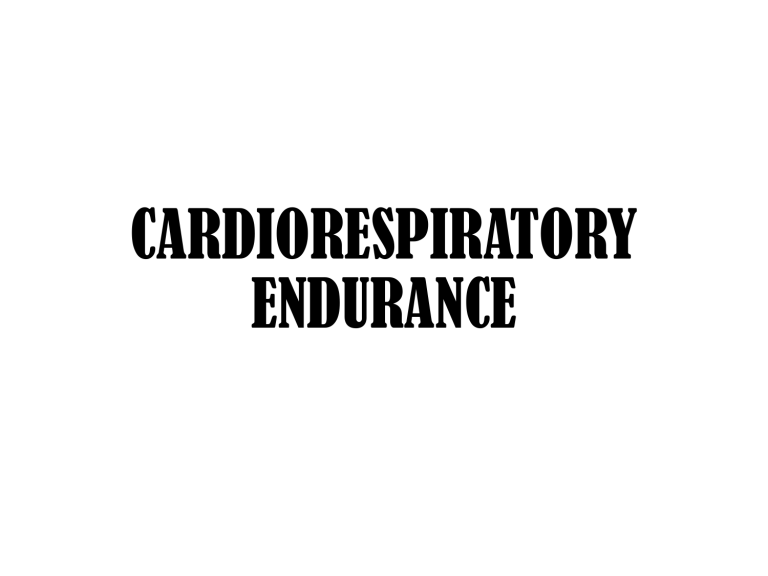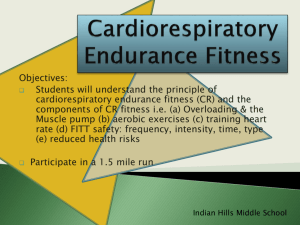
CARDIORESPIRATORY
ENDURANCE
Proponents of the Group
Joseph Sadiarin
John Zyrus Gumarac
Lancce Nicolas
Jennel Marayag
Daine Irish peralta
Lovely Joy Tamundong
Cardiorespiratory endurance
Key benefits:
4. Weight Management: Aids in burning calories and
maintaining a healthy weight.
5. Mental Health: Boosts mood, reduces stress, and
improves overall mental well-being.
Common Activities to Improve
Cardiorespiratory Endurance:
- Running or jogging
- Swimming
- Cycling
- Rowing
- Aerobic dance or classes
- Hiking or brisk walking
Measurement:
Cardiorespiratory endurance is often measured by:
- VO₂ Max: The maximum amount of oxygen your
body can use during intense exercise.
- Fitness tests like the Cooper Run Test, Step Test, or
the Beep Test.
Improving cardiorespiratory endurance involves
consistent aerobic exercise, proper nutrition, and
adequate rest.
warming up
key benefits of warming up:
1. Increased Blood Flow: Delivers oxygen and
nutrients to muscles more effectively.
2. Improved Flexibility: Loosens up muscles and
joints.
3. Enhanced Performance: Prepares the body for
higher intensity.
4. Reduced Risk of Injury: Lowers the likelihood of
muscle strains or sprains.
5. Mental Preparation: Helps you focus and
mentally prepare for the workout.
Components of a Warm-Up:
1. General Warm-Up: Light aerobic activity to
increase overall body temperature.
- Examples: jogging, brisk walking, jumping
jacks.
2. Dynamic Stretching: Moving stretches to
improve range of motion and activate muscles.
- Examples: arm circles, leg swings, lunges, high
knees.
3. Activity-Specific Movements: Low-intensity
versions of the main workout to engage relevant
muscles.
- Example: Practice swings for golfers or light
drills for runners.
Duration:
- Typically lasts 5–10 minutes.
- May vary depending on the intensity and type of
workout. Longer, more intense sessions may
require more time.
Example Warm-Up Routine:
1. 3–5 minutes of light cardio (e.g., jogging in
place or skipping rope).
2. Dynamic stretches, such as:
- Arm circles
- Walking lunges
- Hip rotations
3. Activity-specific preparation (e.g., shadow
boxing for a boxing workout).
Key Benefits of Cooling Down:
1. Gradual Recovery: Helps the cardiovascular
system return to its resting state.
2. Prevents Dizziness: Keeps blood circulating,
preventing it from pooling in the extremities.
3. Reduces Muscle Stiffness: Minimizes soreness
and improves flexibility.
4. Promotes Relaxation: Aids in mental and physical
relaxation post-exercise.
5. Improves Recovery: Enhances the removal of lactic
acid and other metabolic waste.
Components of a Cool-Down:
1. Light Aerobic Activity: Slow, steady movements to
decrease heart rate gradually.
- Examples: slow walking, light jogging.
2. Static Stretching: Hold stretches for 15–30 seconds to
enhance flexibility and reduce muscle tension.
- Examples: hamstring stretch, quad stretch, shoulder
stretch.
3. Deep Breathing Exercises: Focused breathing to calm
the nervous system.
- Example: Inhale deeply through the nose and exhale
slowly through the mouth.
Duration:
- Typically 5–10 minutes, depending on the
intensity of the workout.
- Longer sessions may be needed after intense
activity.
Example of Cool-down routine
Cooling down ensures a smooth transition to rest,
aiding in both physical recovery and mental
relaxation.
Resting heart rate:
Resting heart rate refers to the number of
heartbeats per minute (bpm) while at rest,
typically measured when you wake up in the
morning before getting out of bed. It is an
indicator of your heart's efficiency and overall
fitness. A normal resting heart rate for adults is
usually between 60 and 100 bpm.
Factors that can influence resting
heart rate include:
- Fitness level: Athletes or those in good physical
condition may have a lower resting heart rate
(sometimes as low as 40–60 bpm).
- Age: Resting heart rate can change as you age,
often becoming a bit higher.
- Medications: Certain medications can affect your
heart rate.
- Stress: Anxiety, stress, or excitement can cause a
temporary increase in heart rate.
- Health conditions: Conditions like heart disease,
thyroid disorders, or dehydration can impact your
resting heart rate.
If your resting heart rate is consistently outside the
normal range, or if you notice any other concerning
symptoms, it's advisable to consult a healthcare
professional.

